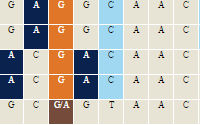
Imported Disease Annotations - ClinVarObject Symbol | Species | Term | Qualifier | Evidence | With | Reference | Notes | Source | Original Reference(s) | Impdh1 | Rat | fundus dystrophy | | ISO | IMPDH1 (Homo sapiens) | 8554872 | ClinVar Annotator: match by term: Retinal dystrophy | ClinVar | PMID:11875049|PMID:11875050|PMID:14981049|PMID:15851576|PMID:15882147|PMID:16384941|PMID:16671097|PMID:17576681|PMID:17851563|PMID:18310263|PMID:19480389|PMID:20045992|PMID:20238057|PMID:20718729|PMID:21791244|PMID:24244438|PMID:25698705|PMID:25741868|PMID:26558346|PMID:28492532|PMID:28945494|PMID:30718709|PMID:31054281|PMID:31213501|PMID:317257|PMID:32037395|PMID:33090715|PMID:9536098 | Impdh1 | Rat | genetic disease | | ISO | IMPDH1 (Homo sapiens) | 8554872 | ClinVar Annotator: match by term: Inborn genetic diseases | ClinVar | PMID:25741868|PMID:28492532 | Impdh1 | Rat | Leber congenital amaurosis | | ISO | IMPDH1 (Homo sapiens) | 8554872 | ClinVar Annotator: match by term: Leber congenital amaurosis | ClinVar | PMID:30718709 | Impdh1 | Rat | Leber congenital amaurosis 11 | | ISO | IMPDH1 (Homo sapiens) | 8554872 | ClinVar Annotator: match by term: Leber congenital amaurosis 11 | ClinVar | PMID:15851576|PMID:16038673|PMID:16384941|PMID:17851563|PMID:19480389|PMID:20045992|PMID:20238057|PMID:20718729|PMID:24244438|PMID:25741868|PMID:26558346|PMID:28488341|PMID:28492532|PMID:28559085|PMID:30718709|PMID:31054281|PMID:317257|PMID:32531858 | Impdh1 | Rat | retinitis pigmentosa | | ISO | IMPDH1 (Homo sapiens) | 8554872 | ClinVar Annotator: match by term: Retinitis Pigmentosa, Recessive | ClinVar Annotator: match by term: Retinitis more ... | ClinVar | PMID:14981049|PMID:16199547|PMID:20045992|PMID:20718729|PMID:24244438|PMID:25698705|PMID:25741868|PMID:28492532|PMID:30718709|PMID:32531858|PMID:33090715 | Impdh1 | Rat | retinitis pigmentosa | | ISO | IMPDH1 (Homo sapiens) | 8554872 | ClinVar Annotator: match by term: Retinitis Pigmentosa, Dominant | ClinVar Annotator: match by term: Retinitis more ... | ClinVar | PMID:20045992|PMID:20718729|PMID:24244438|PMID:25698705|PMID:25741868|PMID:28492532|PMID:30718709 | Impdh1 | Rat | retinitis pigmentosa | | ISO | IMPDH1 (Homo sapiens) | 8554872 | ClinVar Annotator: match by term: Retinitis Pigmentosa, Dominant | ClinVar Annotator: match by term: Retinitis more ... | ClinVar | PMID:20045992|PMID:20718729|PMID:24244438|PMID:25741868|PMID:28166811|PMID:28492532|PMID:30718709 | Impdh1 | Rat | retinitis pigmentosa | | ISO | IMPDH1 (Homo sapiens) | 8554872 | ClinVar Annotator: match by term: Retinitis Pigmentosa, Dominant | ClinVar Annotator: match by term: Retinitis more ... | ClinVar | PMID:20045992|PMID:20718729|PMID:24244438|PMID:25741868|PMID:28492532|PMID:30718709 | Impdh1 | Rat | retinitis pigmentosa 10 | | ISO | IMPDH1 (Homo sapiens) | 8554872 | ClinVar Annotator: match by term: IMPDH1-related condition | ClinVar Annotator: match by term: Retinitis pigmentosa more ... | ClinVar | PMID:11875049|PMID:11875050|PMID:15851576|PMID:15882147|PMID:16384941|PMID:16671097|PMID:17576681|PMID:21791244|PMID:25741868|PMID:26720483|PMID:28492532|PMID:28945494|PMID:33090715|PMID:9536098 | | ||||||||||||||||||||||||||||||||||||||||||||||||||||||||||||||||||||||||||||||||||||||||||||||||||||||||||||||||||||||||||||||||||||||||||||||||||||||||||||||||||||||||||||||||||||||||||||||||||||||||||||||||||||||||||||||||||||||||||||||||||||||||||||||||||||||||||||||||||
|
|
Imported Disease Annotations - CTD
Imported Disease Annotations - OMIM
Gene-Chemical Interaction Annotations Click to see Annotation Detail View
Gene Ontology Annotations Click to see Annotation Detail View
Biological Process
Cellular Component
Molecular Function
Molecular Pathway Annotations Click to see Annotation Detail View










































